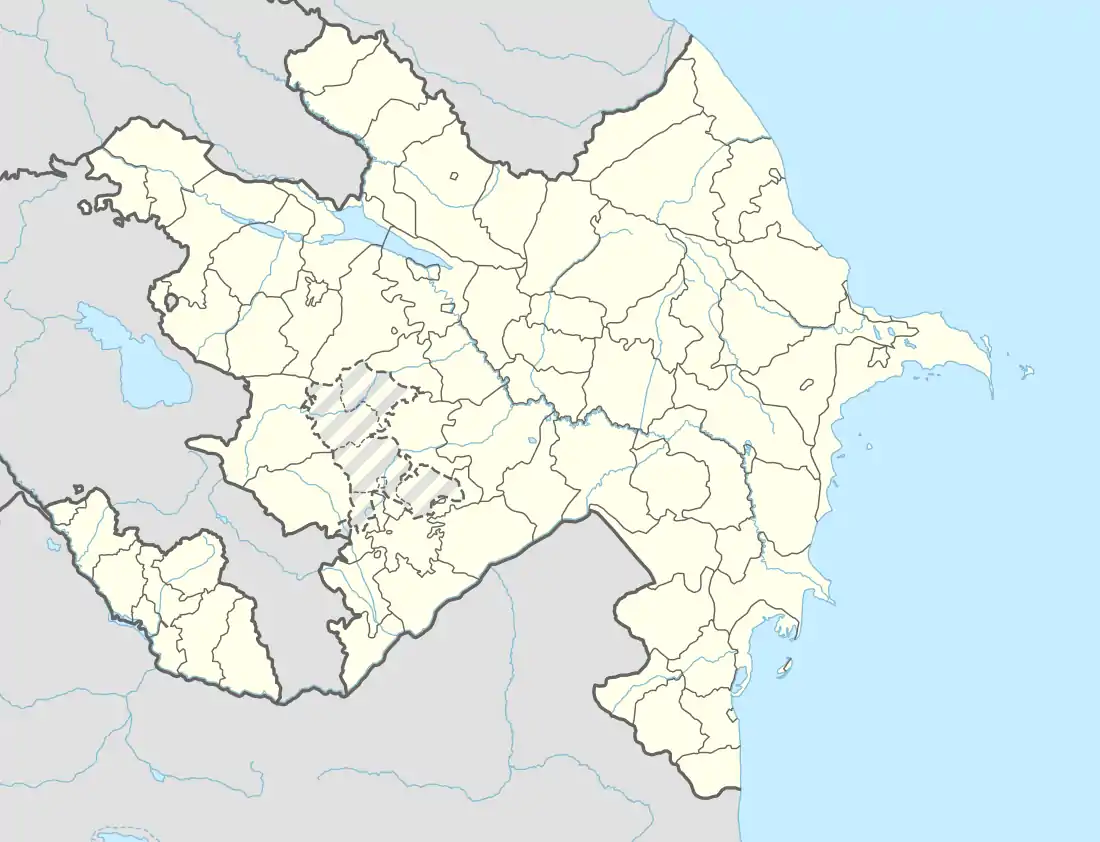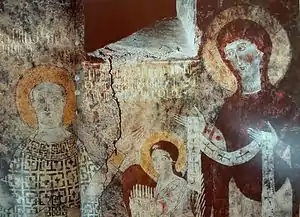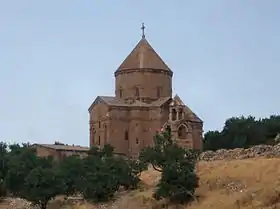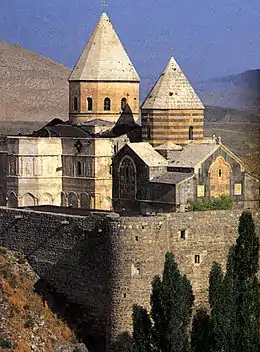Dadivank
Dadivank (Armenian: Դադիվանք, Azerbaijani: Dadivəng), or Khutavank (Azerbaijani: Xudavəng, Armenian: Խութավանք, lit. 'monastery on the hill'[1]), is an Armenian[2][3] monastery in the Kalbajar District of Azerbaijan. It was built between the 9th and 13th centuries. Registered by the Ministry of Culture of Azerbaijan as a monument of global importance,[4] Dadivank the largest monastery complex in Azerbaijan.[5]
| Dadivank Դադիվանք Xudavəng monastırı | |
|---|---|
 The monastery of Dadivank | |
| Religion | |
| Affiliation | Armenian Apostolic Church |
| Location | |
| Location | Vəng, Azerbaijan |
 Shown within Azerbaijan | |
| Geographic coordinates | 40.1616°N 46.2882°E |
| Architecture | |
| Type | Monastery, Church |
| Style | Armenian |
| Completed | 9th–13th centuries |
History and architecture
The monastery was founded by St. Dadi, a disciple of Thaddeus the Apostle who spread Christianity in Eastern Armenia during the first century AD. However, The monastery was first mentioned in the 9th century. In July 2007, the grave of St. Dadi was discovered under the holy altar of the main church.[6] The princes of Upper Khachen are also buried at Dadivank, under the church's gavit.[7]
The Monastery belongs to the Artsakh Diocese of the Armenian Apostolic Church, and consists of the Cathedral church of St. Astvadzadzin, the chapel and a few other buildings. The main church has Armenian script engraved into its walls, in addition to several 13th-century frescoes.[8] The bas-relief on the south facade of the cathedral at Dadivank, built in 1214, shows the princess offering the church in memory of her sons.[9] According to Paolo Cuneo, Dadivank is one of two Monasteries along with Gandzasar where bust motifs (possibly the donors of the monasteries) can be found.[10]
Modern period
In 1994, following the end of the First Nagorno-Karabakh War, the monastery was reopened, and in 2004, a renovation process began with funding from Armenian-American businesswoman Edele Hovnanian, ending in 2005. The restoration efforts restored the cathedral, along with a chapel which was restored by Edik Abrahamian, an Iranian-Armenian from Tehran.[11]
On 8 October 2001, a motion was proposed at the Parliamentary Assembly of the Council of Europe on behest of sixteen parliamentary members on the "Maintenance of historical and cultural heritage in the Nagorno-Karabakh Republic". The motion cited as an example "the destruction of Zar (Tsar) monuments in the Kelbajar region, Dadivank, which the local Muslim population regarded as remnants of the Armenian Christian religion and ruined the monastery as it could".[12]
In August 2017, Italian specialists who had previously conducted restoration operations at Davidank returned to continue their cleaning and restoration of the monastery. They had already restored the four chapels and their frescoes and were planning to restore inscriptions and ornaments near the doors to the chapels. The entire restoration project was planned to be completed by 2020.[13]
2020 war and current status
In the aftermath of the Nagorno-Karabakh war in 2020 which resulted in a ceasefire agreement stipulating an Armenian withdrawal from Kalbajar and a return of the surrounding area to Azerbaijan, the Abbot of the Dadivank Monastery decided to transport the monastery's Christian art of significance, including bells and khachkars, to Armenia.[14] Azerbaijan called it an "illegal activity" and added that it would take action to enforce legal procedures.[15] After the withdrawal of Armenian forces from the region, the monastery was placed under the protection of the Russian peacekeeping forces.[16] However, on 28 November 2020, the Azerbaijani Ministry of Defence released footage from inside the monastery.[17] The Azerbaijani authorities allowed the Armenian monks to stay in the monastery.
On 4 December 2020, representatives of the Udi community of Azerbaijan visited the monastery and performed a prayer inside.[18] The next day, Rafik Danakari, the deputy chairman of the Udi Christian Orthodox community, was appointed preacher at the monastery.[19] A sale-exhibition From Dadivank to Yerevan was held on 16 December at the Museum of Folk Art in the Armenian capital.[15]
In late December additional Armenian clergymen arrived at the monastery and the first wedding ceremony was performed after the war, under Russian peacekeeper protection.[20][21]
Gallery
 Dadivank
Dadivank Fragment of a 13th-century fresco with Armenian inscribed text in Dadivank Monastery, a masterpiece of medieval culture of Artsakh
Fragment of a 13th-century fresco with Armenian inscribed text in Dadivank Monastery, a masterpiece of medieval culture of Artsakh Khachkars at Dadivank
Khachkars at Dadivank Side view
Side view Armenian-inscribed text of Queen Arzu of Haterk, Dadivank Monastery (13th century)
Armenian-inscribed text of Queen Arzu of Haterk, Dadivank Monastery (13th century).jpg.webp) General view
General view 13th century Armenian-inscribed double khachkars of the Memorial bell-tower of the Dadivank Monastery
13th century Armenian-inscribed double khachkars of the Memorial bell-tower of the Dadivank Monastery
See also
| Wikimedia Commons has media related to Dadivank Monastery. |
Books
- (in French) Le Petit Futé Arménie – by Dominique Auzias, Jean-Paul Labourdette – 2009 – 330 pages
- Armenologie in Deutschland, by Armenuhi Drost-Abgarjan, Hermann Goltz – 2005 – p. 59
- (in Italian) Documenti di architettura armena, Alexandr L. Jakobson – 1986 – 73 p.
References
- Жеан-Паул Лабурдетьте, Доминикуе Аузиас, Армения, Petit Futé, 2007 – p. 203
- Robert G. Ousterhout. A Byzantine settlement in Cappadocia. — Dumbarton Oaks, 2006. — p. 151."In the Armenian monastery of Dadivank', however, dated 1211, a four-columned, domed hall is set into a range of rooms chat included the kitchen and refectory."
- "Dadivank", one of the best known Armenian monasteries in Arts'akh (Nagorno - Karabakh)" // Journal of the Society for Armenian Studies (California State University), 1995, vol.6-7, p. 51
- "Dünya əhəmiyyətli daşınmaz tarix və mədəniyyət abidələrinin siyahısı" (PDF) (in Azerbaijani). Ministry of Culture of Azerbaijan. 2 August 2001. Retrieved 1 February 2021.
- Mammadova, Gulchohra (2004). Зодчество Кавказской Албании (in Russian). Baku: Çaşıoğlu. p. 30.
- В старинном монастыре Нагорного Карабаха обнаружены мощи одного из учеников Иисуса Христа
- Georgia, Armenia and Armenia, by John Noble, Michael Kohn, Danielle Systermans, Lonely Planet, 2008 – 364 pages, p. 307
- Lydia А. Durnovo, Essays on the Fine Arts of Medieval Armenia. Moscow. 1979.[In Russian]
- Treasures from the ark: 1700 years of Armenian Christian art, by Vrej Nersessian, British Library, 2001 – 240 pages
- Paolo Cuneo, Architettura Armena, Roma, 1988, pp. 450, 761, cited by. ALPAGHIAN: Raccolta di scritti in onore di Adriano Alpago Novello, Italy, 2005
- "Restoration in Dadivank". Research on Armenian Architecture. 2005. Retrieved 12 November 2020.
- "Doc. 9256 - Parliamentary Assembly of the Council of Europe". Retrieved 13 June 2017.
- "Italian specialists to arrive in Karabakh to continue Dadivank Monastery restoration". News.am. 2 August 2017. Retrieved 12 November 2020.
- "Father Hovhannes of Artsakh's Dadivank Monastery to bring bells and cross to Armenia". News.am. 10 November 2020. Retrieved 12 November 2020.
- "Bu günün xəbərləri: 136 Türkiyə minaaxtaranı Azərbaycanda, Suqovuşan və Talış kəndlərinə gedən yollar asfaltlanır". BBC Azerbaijani Service (in Azerbaijani). 16 December 2020. Retrieved 16 December 2020.
- "Dadivank under protection of Russian peacekeepers". Armenpress.am. 14 November 2020. Retrieved 14 November 2020.
- "Kəlbəcər rayonunun Vəng kəndindən video". BBC Azerbaijani Service. 28 November 2020. Retrieved 28 November 2020.
- "Между удинами и армянскими священниками возник спор в монастыре Худаванг Кельбаджарского района - ВИДЕО". Oxu.az (in Russian). 4 December 2020. Archived from the original on 4 December 2020. Retrieved 4 December 2020.
- "Preacher appointed to Khudavang monastery in Kalbajar". AzVision. 5 December 2020. Archived from the original on 15 December 2020. Retrieved 15 December 2020.
- Ghazanchyan, Siranush (23 December 2020). "New group of Armenian priests leaves for Dadivank". Public Radio of Armenia.
- Ghazanchyan, Siranush (27 December 2020). "Armenian couple marries at Dadivank Monastery". Public Radio of Armenia.



